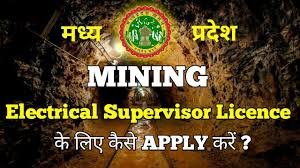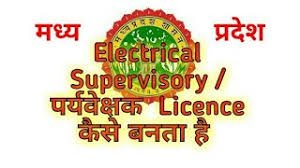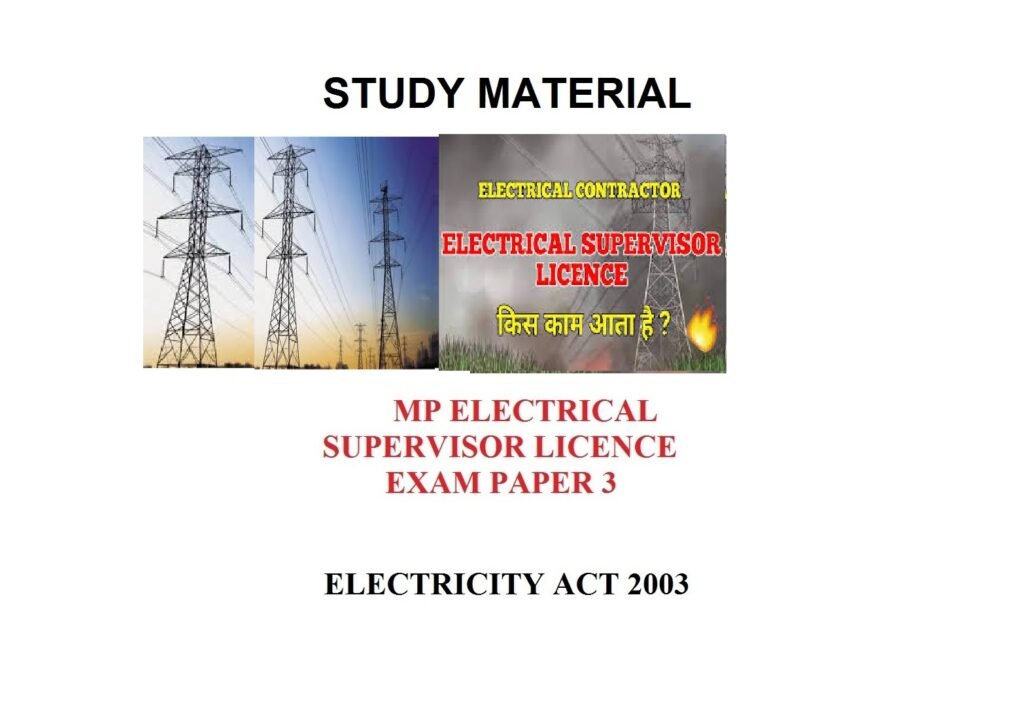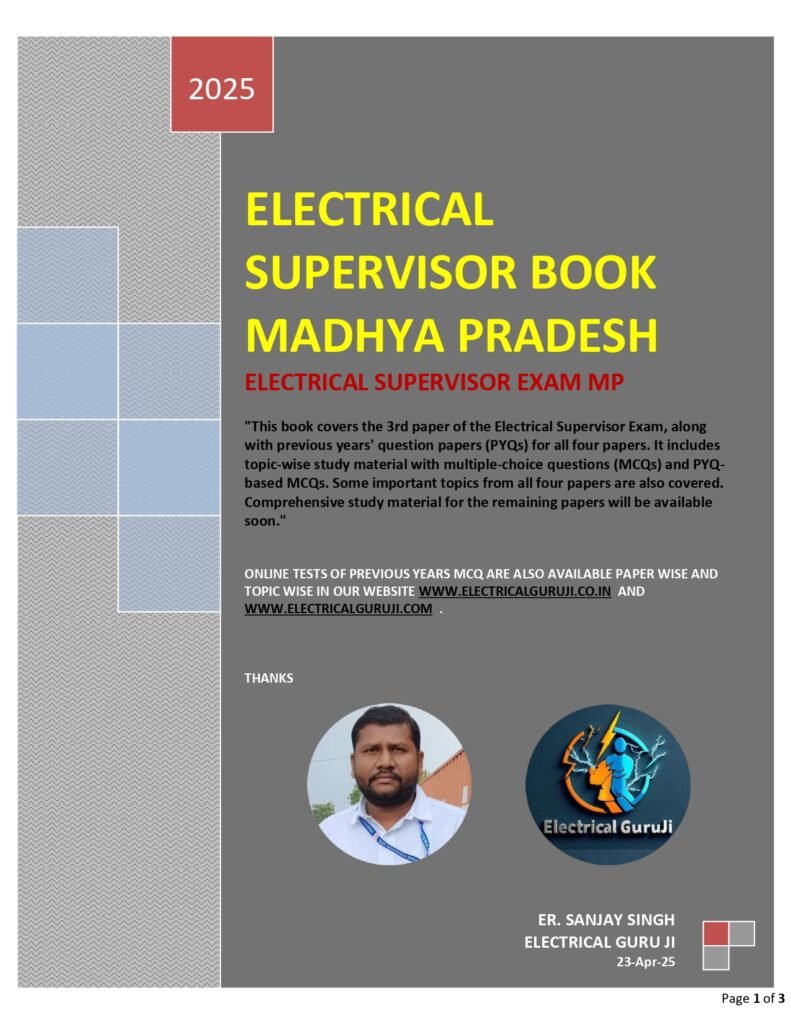Installation testing and maintenance of electrical installations Paper - 3
विद्युत संस्थापनाओं की संस्थापना , परीक्षण तथा उनका अनुरक्षण - प्रश्न पत्र 3
CHAPTER- 1
1. Sections of Electricity Act 2003 / विद्युत अधिनियम 2003 की धाराए
CHAPTER 1. Section of Electricity Act 2003
2,7,8,9,12,13,42,43,52,53,54,55,56,67,68,126,127,128,135,136,138,153
154,161,162,163,164,170,171,176,177,180,181 I
PART I
PRELIMINARY
Section 1. (Short title, extent and commencement) — (1)This Act may be called the Electricity Act, 2003.
(2) It extends to the whole of India except the State of Jammu and Kashmir.
(3) It shall come into force on such date as the Central Government may, by notification, appoint:
Section 2. (Definitions):- — In this Act, unless the context otherwise requires
Section 2. (Definitions): — In this Act, unless the context otherwise requires,–
(1)“Appellate Tribunal” means the Appellate Tribunal for Electricity established
under section 110;
(2) “appointed date” means such date as the Central Government may, by
notification, appoint;
(3) “area of supply” means the area within which a distribution licensee
is authorised by his licence to supply electricity;
(4) “Appropriate Commission” means the Central Regulatory
Commission referred to in sub-section (1) of section 76 or the State
Regulatory Commission referred to in section 82 or the Joint
Commission referred to in section 83, as the case may be ;
(5) “Appropriate Government” means, –
(a) the Central Government, –
(i) in respect of a generating company wholly or partly owned
by it;
(ii) in relation to any inter-State generation, transmission,
trading or supply of electricity and with respect to any
mines, oil-fields, railways, national highways, airports,
telegraphs, broadcasting stations and any works of defence,
dockyard, nuclear power installations;
(iii) in respect of National Load Despatch Centre; and Regional
Load Despatch Centre;
(iv) in relation to any works or electric installation belonging to
it or under its control ;
(b) in any other case, the State Government, having jurisdiction under
this Act;
(6) “Authority” means the Central Electricity Authority referred to in
sub-section(1) of section 70;
(7) “Board” means, a State Electricity Board, constituted before the
commencement of this Act, under sub-section (1) of section 5 of the
Electricity (Supply) Act, 1948;
(8) “Captive generating plant” means a power plant set up by any person
to generate electricity primarily for his own use and includes a power
plant set up by any co-operative society or association of persons for
generating electricity primarily for use of members of such cooperative
society or association;
(9) “Central Commission” means the Central Electricity Regulatory
Commission referred to in sub-section (1) of section 76;
(10) “Central Transmission Utility” means any Government company
which the Central Government may notify under sub-section (1) of
section 38;
(11) “Chairperson” means the Chairperson of the Authority or Appropriate
Commission or the Appellate Tribunal, as the case may be;
(12) “Cogeneration” means a process which simultaneously produces two
or more forms of useful energy (including electricity);
(13) “company” means a company formed and registered under the
Companies Act, 1956 and includes any body corporate under a
Central, State or Provincial Act;
(14) “conservation” means any reduction in consumption of electricity as a
result of increase in the efficiency in supply and use of electricity;
(15) “consumer” means any person who is supplied with electricity for his
own use by a licensee or the Government or by any other person
engaged in the business of supplying electricity to the public under
this Act or any other law for the time being in force and includes any
person whose premises are for the time being connected for the
purpose of receiving electricity with the works of a licensee, the
Government or such other person, as the case may be;
(16) “dedicated transmission lines” means any electric supply-line for point
to point transmission which are required for the purpose of connecting
electric lines or electric plants of a captive generating plant referred to
in section 9 or generating station referred to in section 10 to any
transmission lines or sub-stations or generating stations, or the load
centre, as the case may be;
(17) “distribution licensee” means a licensee authorised to operate and
maintain a distribution system for supplying electricity to the
consumers in his area of supply;
(18) “distributing main” means the portion of any main with which a
service line is, or is intended to be, immediately connected;
(19) “distribution system” means the system of wires and associated
facilities between the delivery points on the transmission lines or the
generating station connection and the point of connection to the
installation of the consumers;
(20) “electric line” means any line which is used for carrying electricity for
any purpose and includes
(a) any support for any such line, that is to say, any structure, tower, pole or
other thing in, on, by or from which any such line is, or may be,
supported, carried or suspended; and
(b) any apparatus connected to any such line for the purpose of carrying
electricity;
(21) “Electrical Inspector” means a person appointed as such by the Appropriate
Government under sub-section (1) of section 162 and also includes Chief
Electrical Inspector;
(22) “electrical plant” means any plant, equipment, apparatus or appliance or any
part thereof used for, or connected with, the generation, transmission,
distribution or supply of electricity but does not include-
(a) an electric line; or
(b) a meter used for ascertaining the quantity of electricity supplied to any
premises; or
(c) an electrical equipment, apparatus or appliance under the control of a
consumer;
(23) “electricity” means electrical energy-
(a) generated, transmitted, supplied or traded for any purpose; or
(b) used for any purpose except the transmission of a message;
(24) “Electricity Supply Code” means the Electricity Supply Code specified under
section 50;
(25) “electricity system” means a system under the control of a generating
company or licensee, as the case may be, having one or more –
(a) generating stations; or
(b) transmission lines; or
(c) electric lines and sub-stations;
and when used in the context of a State or the Union, the entire electricity system
within the territories thereof;
(26) “electricity trader” means a person who has been granted a licence to
undertake trading in electricity under section 12;
(27) “franchisee means a persons authorised by a distribution licensee to
distribute electricity on its behalf in a particular area within his area of
supply;
(28) “generating company” means any company or body corporate or
association or body of individuals, whether incorporated or not, or artificial
juridical person, which owns or operates or maintains a generating station;
(29) “generate” means to produce electricity from a generating station for the
purpose of giving supply to any premises or enabling a supply to be so given;
(30) “generating station” or “station” means any station for generating
electricity, including any building and plant with step-up transformer, switchgear,
switch yard, cables or other appurtenant equipment, if any, used for that
purpose and the site thereof; a site intended to be used for a generating station,
and any building used for housing the operating staff of a generating station, and
where electricity is generated by water-power, includes penstocks, head and tail
works, main and regulating reservoirs, dams and other hydraulic works, but
does not in any case include any sub-station;
(31) “Government company” shall have the meaning assigned to it in section 617
of the Companies Act, 1956;
(32) “grid” means the high voltage backbone system of inter-connected
transmission lines, sub-stations and generating plants;
(33) “Grid Code” means the Grid Code specified by the Central Commission
under clause (h) of sub-section (l) of section 79;
(34) “Grid Standards” means the Grid Standards specified under clause (d) of
section 73 by the Authority;
(35) “high voltage line” means an electric line or cable of a nominal voltage as
may be specified by the Authority from time to time;
(36) “ inter-State transmission system” includes –
(i) any system for the conveyance of electricity by means of main
transmission line from the territory of one State to another State;
(ii) the conveyance of electricity across the territory of an intervening
State as well as conveyance within the State which is incidental to
such inter-State transmission of electricity;
(iii) the transmission of electricity within the territory of a State on a
system built, owned, operated, maintained or controlled by a
Central Transmission Utility.
(37) “intra-State transmission system” means any system for transmission of
electricity other than an inter-State transmission system ;
(38) “ licence” means a licence granted under section 14;
(39) “ licensee” means a person who has been granted a licence under
section 14;
(40) “ line” means any wire, cable, tube, pipe, insulator, conductor or other
similar thing (including its casing or coating) which is designed or adapted for
use in carrying electricity and includes any line which surrounds or supports,
or is surrounded or supported by or is installed in close proximity to, or is
supported, carried or suspended in association with, any such line;
(41) “local authority” means any Nagar Panchayat, Municipal Council,
municipal corporation, Panchayat constituted at the village, intermediate and
district levels, body of port commissioners or other authority legally entitled to,
or entrusted by the Union or any State Government with, the control or
management of any area or local fund;
(42) “main” means any electric supply- line through which electricity is, or is
intended to be, supplied ;
(43) “Member” means the Member of the Appropriate Commission or Authority
or Joint Commission, or the Appellate Tribunal, as the case may be, and includes
the Chairperson of such Commission or Authority or Appellate Tribunal;
(44) “National Electricity Plan” means the National Electricity Plan notified under
sub-section (4) of section 3;
(45) “National Load Despatch Centre” means the Centre established under subsection
(1) of section 26;
(46) “notification” means notification published in the Official Gazette and the
expression “notify” shall be construed accordingly;
(47) “open access” means the non-discriminatory provision for the use of
transmission lines or distribution system or associated facilities with such lines
or system by any licensee or consumer or a person engaged in generation in
accordance with the regulations specified by the Appropriate Commission;
(48) “overhead line” means an electric line which is placed above the ground and
in the open air but does not include live rails of a traction system;
(49) “person” shall include any company or body corporate or association or
body of individuals, whether incorporated or not, or artificial juridical person;
(50) “power system” means all aspects of generation, transmission, distribution
and supply of electricity and includes one or more of the following, namely:-
(a) generating stations;
(b) transmission or main transmission lines;
(c) sub-stations;
(d) tie-lines;
(e) load despatch activities;
(f) mains or distribution mains;
(g) electric supply-lines;
(h) overhead lines;
(i) service lines;
(j) works;
(51) “premises” includes any land, building or structure;
(52) “prescribed” means prescribed by rules made by the Appropriate
Government under this Act;
(53) “public lamp” means an electric lamp used for the lighting of any street;
(54) “real time operation” means action to be taken at a given time at which
information about the electricity system is made available to the concerned Load
Despatch Centre;
(55) “Regional Power Committee” means a committee established by resolution
by the Central Government for a specified region for facilitating the integrated
operation of the power systems in that region;
(56) “Regional Load Despatch Centre” means the Centre established under subsection
(1) of section 27;
(57) “regulations” means regulations made under this Act;
(58) “repealed laws” means the Indian Electricity Act, 1910, the Electricity
(Supply) Act, 1948 and the Electricity Regulatory Commissions Act, 1998
repealed by section 185;
(59) “rules ” means rules made under this Act;
(60) “schedule” means the Schedule to this Act;
(61) “service-line” means any electric supply-line through which electricity is, or
is intended to be, supplied –
(a) to a single consumer either from a distributing main or
immediately from the Distribution Licensee’s premises; or
(b) from a distributing main to a group of consumers on the same
premises or on contiguous premises supplied from the same point
of the distributing main;
(62) “specified” means specified by regulations made by the Appropriate
Commission or the Authority, as the case may be, under this Act;
(63) “stand alone system” means the electricity system set-up to generate power
and distribute electricity in a specified area without connection to the grid;
(64) “State Commission” means the State Electricity Regulatory Commission
constituted under sub-section (1) of section 82 and includes a Joint Commission
constituted under sub-section (1) of section 83;
(65) “State Grid Code” means the State Grid Code specified under clause (h) of
sub-section (1) of section 86;
(66) “State Load Despatch Centre” means the centre established under subsection
(1) of section 31;
(67) “State Transmission Utility” means the Board or the Government company
specified as such by the State Government under sub-section (1) of section 39;
(68) “street” includes any way, road, lane, square, court, alley, passage or open
space, whether a thoroughfare or not, over which the public have a right of way,
and also the roadway and footway over any public bridge or causeway;
(69) “sub-station” means a station for transforming or converting electricity for
the transmission or distribution thereof and includes transformers converters,
switch-gears, capacitors, synchronous condensers, structures, cable and other
appurtenant equipment and any buildings used for that purpose and the site
thereof;
(70) “supply”, in relation to electricity, means the sale of electricity to a licensee or
consumer;
(71) “trading” means purchase of electricity for resale thereof and the expression
“trade” shall be construed accordingly;
(72) “transmission lines” means all high pressure cables and overhead lines (not
being an essential part of the distribution system of a licensee) transmitting
electricity from a generating station to another generating station or a substation,
together with any step-up and step-down transformers, switch-gear and
other works necessary to and used for the control of such cables or overhead
lines, and such buildings or part thereof as may be required to accommodate
such transformers, switch-gear and other works;
(73) “transmission licensee” means a licensee authorised to establish or operate
transmission lines;
(74) “transmit” means conveyance of electricity by means of transmission lines
and the expression “transmission” shall be construed accordingly;
(75) “utility” means the electric lines or electrical plant, and includes all lands,
buildings, works and materials attached thereto belonging to any person acting
as a generating company or licensee under the provisions of this Act;
(76) “wheeling” means the operation whereby the distribution system and
associated facilities of a transmission licensee or distribution licensee, as the case
may be, are used by another person for the conveyance of electricity on payment
of charges to be determined under section 62;
(77) “works” includes electric line, and any building, plant, machinery,
apparatus and any other thing of whatever description required to transmit,
distribute or supply electricity to the public and to carry into effect the objects of
a licence or sanction granted under this Act or any other law for the time being in
force.
PART I
PRELIMINARY
Section 1. (Short title, extent and commencement) — (1)This Act may be called the Electricity Act, 2003.
(2) It extends to the whole of India except the State of Jammu and Kashmir.
(3) It shall come into force on such date as the Central Government may, by notification, appoint:
Section 2. (Definitions):- — In this Act, unless the context otherwise requires
PART III
GENERATION OF ELECTRICITY
Section 7. (Generating company and requirement for setting up of generating station)
Section 8. (Hydro-electric generation)
Section 9. (Captive generation)
PART IV
LICENSING
Section 12. (Authorised persons to transmit, supply, etc., electricity)
Section 13. (Power to exempt)
PART VI
DISTRIBUTION OF ELELCTRICITY
Provisions with respect to distribution licensee
Section 42. (Duties of distribution licensee and open access)
Section 43. Section 43. (Duty to supply on request)
Section 52. (Provisions with respect to electricity traders)
Section 53. (Provisions relating to safety and electricity supply)
Section 54. (Control of transmission and use of electricity)
Section 55. (Use, etc., of meters
Section 56. (Disconnection of supply in default of payment)
PART VIII
WORKS
Works of licensees
Section 67. (Provisions as to opening up of streets,railways, etc)
Section 68. (Provisions relating to Overhead lines)
PART XII
INVESTIGATION AND ENFORCEMENT
Section 126: (Assessment)
Section 127. (Appeal to Appellate Authority)
Section 128. (Investigation of certain matters)
PART XIV
OFFENCES AND PENALTIES
Section 135. (Theft of Electricity)
Section 136. (Theft of electric lines and materials)
Section 138. (Interference with meters or works of licensee)
PART XV
SPECAIL COURTS
Section 153. (Constitution of Special Courts)
Section 154. (Procedure and power of Special Court)
Section 161. (Notice of accidents and injuries)
Section 162. (Appointment of Chief Electrical Inspector and Electrical Inspector)
Section 163. (Power for licensee to enter premises and to remove fittings or other apparatus of licensee)
Section 164. (Exercise of powers of Telegraph Authority in certain cases)
PART XVIII
MISCELLANEOUS
Section 170. (Recovery of penalty payable under this Act)
Section 171. (Services of notices, orders or documents)
Section 176. (Power of Central Government to make rules)
Section 177. (Powers of Authority to make regulations)
Section 180. (Powers of State Governments to make rules)
Section 181. (Powers of State Commissions to make regulations)
MP ELECTRICAL SUPERVISOR LICENCE EXAM
केन्द्रीय विद्युत प्राधिकरण (सुरक्षा एवं विद्युत आपूर्ति संबंधी उपाय) विनियम 2010 के विनियम 29 में प्रावधान है कि स्थापना का स्वामी, विद्युत ठेकेदार, परमिटधारी व्यक्ति से कार्य करायेगा। परमिटधारी व्यक्ति से तात्पर्य यह है कि फिटिंग करने वाला व्यक्ति जैसे घरेलू वायरिंग, औद्योगिक फिटिंग, शिरोपरि लाइनें एवं भूमिगत केबल की स्थापना का कार्य।
इलेक्ट्रिशियन के द्वारा विद्युत फिटिंग का कार्य संपादित किया जायेगा, जिन्होंने कार्य करते हुए दो वर्ष का अनुभव लिया है। इसके बाद वह वायरमेन की परीक्षा दे सकते हैं।
विद्युत व्यवस्था में डिजाइन, योजना एवं कार्य कराने वाला व्यक्ति, एक अन्य व्यक्ति है, जो परमिटधारी इलेक्ट्रिशियन व्यक्तियों के माध्यम से कार्य करा सकता है और ऐसे कार्य कराने वाले व्यक्ति तकनीकी रूप से दक्ष होकर विद्युत स्थापना का पर्यवेक्षण करते हैं। ऐसे पर्यवेक्षण करने वाले व्यक्ति को यह आवश्यक है कि विनियम 29 के अंतर्गत सुपरवाइज़र परमिट प्राप्त करें। सुपरवाइज़र परमिट प्राप्त करने के लिए यह आवश्यक है कि वह तकनीकी योग्यता के साथ-साथ कम से कम 2 वर्ष का व्यावहारिक अनुभव रखता हो ताकि वह भिज्ञ हो सके कि व्यक्ति वास्तविक विद्युत का कार्य कराने के लिए दक्ष हो गया है। पर्यवेक्षक परीक्षा देकर उत्तीर्ण करने के बाद वह पर्यवेक्षक परमिटधारी व्यक्ति हो जाता है।



APPLY ONLINE
OLD PAPERS
Eligbility
Rules and Regulation for Applying Under Supervisory Exam
1- Applying under mining
A- If Candidate have: 10+2 with (PCM)+ITI (Electrician trade)+ 5 years
Experience, candidate will give paper 1st 4th & mining oral/practical.
B- if Candidate have: 10+2 with (PCM)+ tar mistry (wiremen) permit passed in 2
subject (2 out of 4) +5 years’ experience. Candidate will give paper 1st 4th & mining
oral/practical.
C- If Candidate have: degree/diploma in engineering (other than Electrical)+ 2
years experience. Candidate will be eligible to give paper 1st,4th & mining
oral/practical.
D- If candidate have: degree/diploma in (Electrical)+ 2 years experience.
Candidate will be eligible to give paper 4th& mining oral/practical only.
2- Applying under non mining
A- If candidate have: 10+2 with (PCM)+ITI (Electrician trade)+5 years experience,
candidate will be eligible to give paper 1st, 2nd, 3rd and non mining oral/practical.
B- If candidate have: 10+2 with (PCM)+ tar mistry (wiremen) permit passed in 2
subject (2 out of 4)+5 years experience, candidate will give paper 1st, 2nd, 3rd & non
mining oral/practical.
C- If candidate have: degree/diploma/polytechnic in engineering (other than
Electrical)+ 2 years experience, candidate will give paper 1st ,2nd, 3rd & non mining
oral/practical.
D- If candidate have: degree/diploma in (Electrical)+ 2 years experience,
candidate will be eligible to give paper 3rd only.
3- Applying under both for mining/non mining, rules will be taken
Commonly as mention above.
4. Mandatory Terms and Conditions
1. It is mandatory that the departmental fee for mining and non mining is Rs.40/-
for each examination and in case of Both department fees will be Rs 80 and to be
paid by cyber treasury.
2. Work experience from outside the State of Madhya Pradesh is not acceptable
And not allowed.
3. The experience of the Contractor will only be valid when candidate has been
Registered as a trainee in the M.P. Licensing Board (Electrical safety
Department).
4. Only High Tension Consumer work experience will be acceptable.
5. It is mandatory that the applicant is being lived in Madhya Pradesh State for
at least 3 years.
6. Experience Certificate should be issued on Institution’s Letter-head including
The competency of the Institution, Name and the designation of the issuing
Officer with their email id & mobile number.
7. 2 years work experience is mandatory after the completion of Diploma
/Degree in Engineering.
8. 5 years work experience is mandatory after the completion of 12th PCM+ITI
(Electrician trade)
9. 5 years work experience is mandatory after the completion of 12th
PCM+ wireman permit any 2 subject. (Domestic, industrial, overhead,
Underground)
10. Work experience is not acceptable before last 5 year.
11. If the candidate is applying for mining subject then the experience is
Mandatory for mining work. (ex:-coal mines)



